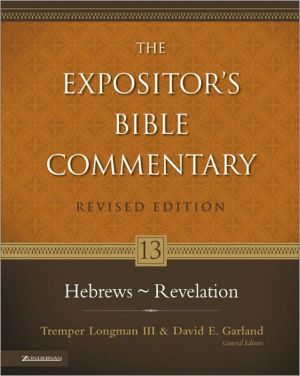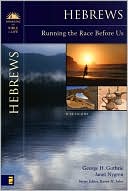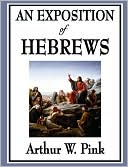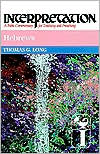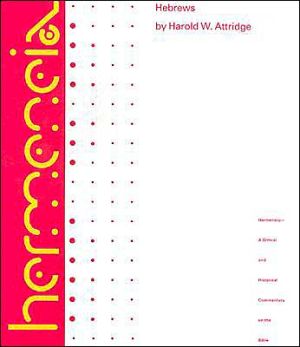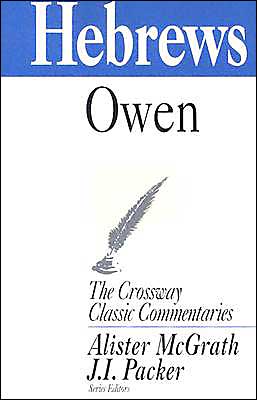The Expositors Bible Commentary: Hebrews - Revelations, Vol. 13
Continuing a Gold Medallion Award-winning legacy, this completely revised edition of The Expositor's Bible Commentary series puts world-class biblical scholarship in your hands.\ Based on the original twelve-volume set that has become a staple in college and seminary libraries and pastors' studies worldwide, this new thirteen-volume edition marshals the most current evangelical scholarship and resources. You'll find up-to-date information grounded in the same unchanging commitment to the...
Search in google:
This is a complete revision of the Gold Medallion-winning commentary series. It is up to date in its discussion of theological and critical issues and thoroughly evangelical in its viewpoint.
The Expositor's Bible Commentary: Hebrews-Revelation\ \ Zondervan\ Copyright © 2006 Zondervan Corporation\ All right reserved. \ ISBN: 0-310-26894-X \ \ \ \ Chapter One\ Text and Exposition \ I. BETTER THAN THE PROPHETS (1:1-3)\ OVERVIEW\ The first four verses of Hebrews form a single Greek sentence. By the end of the sentence, we have already been introduced to the theme of the superiority of the Son to angels, which will remain in focus throughout the rest of chs. 1-2. To impose a section break between vv.3 and 4 is therefore to favor a thematic analysis of the text over its grammatical form. My reason for doing so is that the contrast with the prophets with which the sentence opens (and which will not be made explicitly again in the rest of the letter) serves to set the scene more broadly than just in relation to angels and provides our author with the cue for his most powerful christological statement-indeed one of the three or four most striking accounts in the NT of the incarnate Son of God. The theme and indeed much of the language of vv.2-3 is closely parallel to what is said about the role of the Word/Son in creation and revelation in John 1:1-18 and especially Colossians 1:15-20.\ COMMENTARY\ 1-2a One of the chief glories of OT religion was its prophetic tradition. Israel lived not by human insight but by divine revelation as God "spoke through the prophets." Our author has no wish to belittle this privilege, and he will quote from those same prophets later in the course of his argument. But now God has provided something even better. The prophets were many and varied, and their revelations came to the forefathers sporadically over a considerable period. But now their place has been taken by a single spokesman, whose message has been delivered once-for-all "in these last days" (lit., "at the end of these days," echoing the OT formula "in the end of the days," Ge 49:1; Isa 2:2; etc.).The period of preparation is over, and all that the prophets have looked forward to is now fulfilled in the single person of "a Son." (The lack of article does not indicate one son among many but rather the true nature and status of this new spokesman as against his predecessors the prophets.) This title, which will form the backbone of Hebrews' presentation of Jesus, is dramatically introduced in contrast with the mere messengers who have gone before and will immediately be filled out with a series of descriptive clauses that totally set him apart from all merely human representatives. Note that the name "Jesus" will not appear until 2:9, when the focus will be on the period of the human incarnation of the Son. In his essential nature he is better designated not by his human name but by a title that directly links him to God.\ 2b-3a Seven arresting statements now fill out the unique status of "the Son" and make it unmistakably clear he is much more than a passing historical figure like the prophets. The first five statements focus on his relationship to God and to the created universe in such a way as to place him outside the natural order as its originator and sustainer. Two further clauses in v.3b will then bring his historical work of redemption into focus, but first we are invited to contemplate the eternal glory of the Son since before the world was made.\ Three clauses trace the role of the Son in relation to the universe, covering respectively its past, present, and future. It was "through" the Son that God made the universe in the past; in the present that same Son upholds everything "by his powerful word"; and the future destiny of the universe is understood also in relation to him who has been made the "heir of all things" (perhaps echoing Ps 2:8; cf. the quotation of Ps 2:7 that follows in v.5). This is the same threefold relation to the creation, embracing all eternity, which is succinctly expressed in Paul's formula in Romans 11:36: "from him and through him and to him are all things"; Paul was speaking there of God, not of Christ, but in Colossians 1:16-17 he says the same of Christ: "all things were created by him and for him ..., and in him all things hold together." The author of Hebrews, like Paul (and John in 1:1-3), has no hesitation in saying of Jesus what in Jewish orthodoxy was reserved for God the Creator.\ The double clause that opens v.3 describes the Son's relation to God more directly and even more unequivocally, not now in his creative role but in his essential nature: he is "the radiance of God's glory and the exact representation of his being." He is, in other words, as in John 1:14, 18, God made visible. To see what God is like we must look at the Son. "Radiance" (apaugasma, GK 575) means literally the "outshining" (though it is sometimes also used of a "reflection") of the glory that is God's essential character, while "exact representation" translates the vivid Greek metaphor charakter, "imprint, stamp" (GK 5917), used, for instance, of the impression made on a coin, which exactly reproduces the design on the die. (The idea is the same as the more familiar phrase "the image of God.") Again there is a close echo of Colossians 1:15, 19: "He is the image of the invisible God.... God was pleased to have all his fullness dwell in him."\ 3b The glory of the Son consists not only in his eternal nature but also in his role in bringing salvation to human beings. The two clauses that conclude the description of the Son take up this theme and thus introduce two of the most prominent themes of the letter as a whole. First, he has "provided purification for sins." The theme of the sacrificial work of Christ will come into focus especially in chs. 9-10 as the outworking of his office as our great high priest, where the author will emphasize that this work of purification is now fully complete. While at this point he does not yet spell out the means by which this "purification" has been achieved, his readers would be well aware that it must be through the shedding of blood (9:14, 22, etc.). The way is thus prepared for the paradoxical argument of ch. 2 that it is in his humiliation and death that the superior glory of the Son, as our perfect redeemer, is revealed.\ But humiliation is followed by exaltation, and the author's first allusion to Psalm 110:1 introduces the language of "sitting at the right hand," which will echo through the letter (cf. 1:13; 8:1; 10:12; 12:2). The Son, his earthly work complete, now occupies in heaven the place of highest authority next to God himself.\ Such is the nature of the Son, who has now added to his unique creative work by coming into the world he made in order to bring the final and perfect revelation of God by making the true nature of the invisible God visible on the canvas of a human life, and by his redeeming work has fulfilled God's purpose of salvation. "The Word became flesh and made his dwelling among us. We have seen his glory" (Jn 1:14). Here is a work of God on a different level altogether from what the prophets could offer.\ (Continues...)\ \ \ \ \ Excerpted from The Expositor's Bible Commentary: Hebrews-Revelation Copyright © 2006 by Zondervan Corporation. Excerpted by permission.\ All rights reserved. No part of this excerpt may be reproduced or reprinted without permission in writing from the publisher.\ Excerpts are provided by Dial-A-Book Inc. solely for the personal use of visitors to this web site. \ \
Contributors to Volume Thirteen6Preface7Abbreviations9Hebrews17James1971 Peter2752 Peter3571 John4132 John5073 John525Jude539Revelation571
